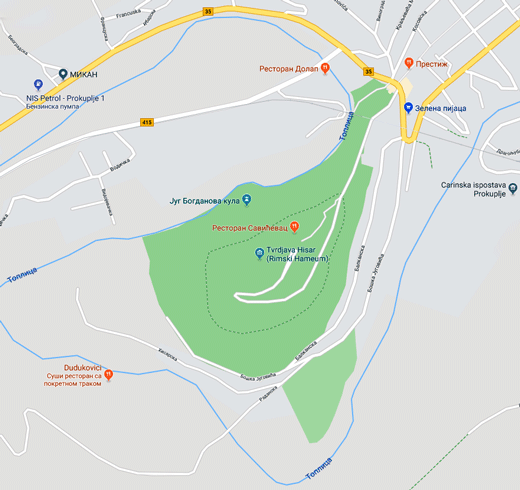PROKUPLJE FORTRESSHISAR
Protected cultural monument of great importance, listed as SK 2052 with the Republic Institute for the protection of monuments of cultural heritage.
PROKUPLJE FORTRESSHISAR TOWNProkuplje
Location
Prokuplje fortress stands at the entrance to today’s city, on the west side, on the Hisar hill, and is surrounded by the Toplica river from three sides, protecting it. The river Toplica, coming from the west, meets the hill and partially flows upstream around it, thus making a unique natural phenomenon.

Research
Archaeological research of the fortress begun in 1976, organized by National museum of Toplica and the Institute for the protection of the monuments of cultural heritage from Nis, and lasted, intermittently, until 1995. The Upper town was researched, as well as a part of the suburb by the north wall with water cistern. The conservatory protection of the discovered objects took place at the same time.

History
The oldest plan of Prokuplje fortress, discovered in Vienna archives, was made in 1689. It is a rather faithful schematic representation of the city. A photograph taken in 1878, when the hill had still not been afforested, shows the remains of two concentric ramparts with three rather well-preserved towers on the outer rampart. Felix Kanitz, an Austrian painter, made a summary plan of the fortification in late 19th century. He believed the fortification to be Roman.

The results of the research of the minor part of the fortress indicate that it was built in the second half of the 14th century, at the time when the Turkish invasion from the east was certain, probably between 1371 and 1389. The Turks temporarily invaded Prokuplje in 1440 and finally in 1454. They placed their army in the fortress, and the civilians in the suburb.
Description
The fortress contains the Upper town in the highest plateau and two suburbs surrounded by a rampart. The Upper town takes up the highest plateau on the Hisar hill and is of irregular, oval shape about 600 square meters. During the construction, the direction of the rampart was dictated by the configuration of the terrain. The north rampart was funded directly into the rock, as on this side the cliff towards the Toplica river is steep and the rampart is narrower than on the other sides. On the east side, where the slope is milder, the rampart is significantly wider and protected with a dry moat. The entrance to the Upper town is protected by a high keep, which has a square base. There is another entrance on the north side, a small gate that was connected with the tower near the Toplica with stairs. The only object in the Upper town is a water cistern, cut inside the rock and filled with gravel, with a central well that was used for drawing water.

The first suburb is located east and southeast from the Upper town. Next to the north rampart there is a water cistern, which shows signs of two phases of build. The younger phase certainly corresponds to the medieval edifice and is built in the same way as the cistern in the Upper town. Near the north wall hearths and numerous broken utensils were also discovered, pointing to the life of the edifice during sieges when local civilians used to take shelter here.
Three towers are preserved on the south and southeast part of the rampart, protecting the access to the fort from a milder slope.
A high keep is also preserved next to the Toplica river, probably used to protect the river crossing and the water supply.
The ramparts are built with crushed stone bound with lime mortar. The thicker parts of the rampart are built in such a way that the outer and inner sides of the wall are made of stone, while the insides are filled with smaller stones and bound with lime mortar.
Folk belief
In the folk tradition, the Prokuplje fortress was built by Jug Bogdan who ruled over this area. The tower by the Toplica river is known as Jug Bogdan’s tower. He is also credited with having built the small church at the foot of the hill, built in the 14th century. The legend has it that Jug Bogdan had 9 sons and a daughter, Milica, who was married to prince Lazar.
The history notes that princess Milica, with her sons Stefan and Vuk, in 1395 presented the Monastery of St. Panteleimon in Mount Athos with a gift of two men and estates in the city of Saint Procopius (Prokuplje). This is, in fact, the first mention of the town of Prokuplje, by that name.

Julka Kuzmanović Cvetkovićarcheologist
